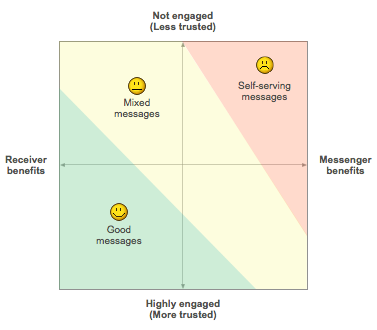
Trust is critical for companies (and some individuals) trying to engage in social media, but it’s only part of the equation when it comes to messages in social media related to products or services.
This morning, I came across a Twitter message from a social media author whom I both follow and respect. He was sending out a message about his new book (which I already own), encouraging people who were out and about to go to their local bookstore. I’ve seen a few other authors send out similar messages about their latest books. Writing a book is hard work, and the people I’m referring to do great stuff, so I totally understand their desire to promote their efforts. They also have a product (their ideas) worth paying for.
At the same time, my gut reaction to these (repeated) messages has been mixed, because it feels like advertising unintentionally masquerading as a more personal attempt at connection. It also feels like the way these authors encourage brands to engage, rather than push messages, is somewhat at odds with their own practices. I want to give them the benefit of the doubt, which makes me examine my reactions to their book promotions.
As I thought about it, a few questions seemed relevant to me when looking at how a message about a good or product can be received:
- What’s the difference between simple sharing, self-promotion, and push advertising?
- Does it matter whether the messages come from individuals (“personal brands”) or faceless corporate brands?
- Is the cost of the good being promoted relevant?
In all of the following discussion, I’ll use the term message to mean “product-oriented message” (as opposed to something that’s purely conversational or informational). I’ll also assume that engagement and trust are somewhat synonymous (i.e., let’s assume that the engagement is the kind that fosters trust).
Sharing, self-promotion and advertising
Intent, content and delivery style will all impact how a message is perceived along this spectrum:
- Intent relates to whether the message is shared for personal or external benefit. The less someone benefits from the message they deliver, the more it seems like sharing. Advertising presents a more nuanced challenge, because it’s often perceived as unwanted “push” messaging that’s more about selling product as opposed to providing real value.
- Content is the actual substance of the message (independent of how it’s rendered or delivered). Language matters, and two different approaches for the same underlying message can be received completely differently (e.g., “Buy my book! It rocks!” vs. “After 6 months, our book is finally done…We think you’ll find some ideas to help your business thrive. Thanks for any feedback!”)
- Delivery style is how the message appears (i.e., its visual style and the medium in which it appears). The same message delivered in Twitter (text only) might be received differently than a print or online ad with typographic treatment, images and color. While style definitely matters, it’s not enough to trump substance and intent.
Message source
Who’s delivering the message? Is it a faceless corporate brand? A stay-at-home Mom with three kids? An independent consultant whom I’ve met before? A friend who likes something and wants to recommend it to me? It’s not so much the source that matters. What matters is whether or not they are engaged with you and trusted, and the degree to which they stand to benefit from telling you something.
For example, if a good friend recommends a book to you, does it matter that they get a kickback from the author for every book they sell? What if an independent reviewer (whom you don’t know and who stands to gain nothing) gives you the same message? In this context, trust and benefit are highly correlated, because the more someone stands to benefit from something, the less we tend to trust that their message comes from the goodness of their hearts for our benefit.
Cost of good being promoted
In most cases, I’d venture this is secondary to the benefit received by the person promoting the good. If the source isn’t trusted, then any cost more than “free” is going to be met with skepticism. Conversely, if a source is highly trusted and engaged, then as long as the receiver of a message feels like the benefit outweighs the cost, the message will be more well-received. Of course, as cost becomes prohibitive, this whole calculus breaks down and cost becomes the deciding factor.
Engagement vs. Benefit: A model for messaging
Based on everything put forward above, I’m going to propose a two-dimensional model for how product messages are received.

Stive for both engagement and mutual benefits in your social media messaging
In a nutshell, the less engaged and less trusted the source, the more we care about the degree to which they benefit from the message they’re putting forward. The more engaged and trusted the messenger, the more people will look at how they benefit relative to the messenger, assuming good will if it seems to be of mutual benefit. In other words, we will tend to assume the source is more virtuous if they are more engaged and trusted, even if the message (and benefits) are exactly the same to us.
Let’s go back to what started this whole thing: a social media author suggests that you stop by the bookstore for their latest offering. Clearly, this falls into the mixed feelings zone for messaging. They stand to benefit significantly (i.e., if I buy their book), whereas my return on the expenditure depends on the content of the book. I’m engaged with them to the extent that I follow them on Twitter and know people who know them, but they aren’t my friends, and I’ve never really talked with them. And so I wind up feeling confused, unsure which way the benefit scale tips (i.e., book sale vs. book value to me) relative to my trust in their message.
Balance the forces of trust and benefit
Whether you’re a brand or an individual, when it comes to social media, it’s important to consider your level of engagement with your audience, and how much you stand to benefit from the (product) messages you deliver relative to your audience. If you’re not engaged (and maybe even if you are), you better be sharing more than you stand to benefit. Conversely, if you’re engaged with your audiences, but you benefit most from your messages, consider how that might come across and affect perceptions over time.
Balance the forces of trust and mutual benefit and everyone wins.
NOTE: Don’t mistake the title of this post or its content as a criticism of Brogan and Smith’s Trust Agents, a seminal work in the expanding field of social media. Read their stuff, it’s great.





